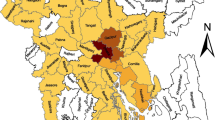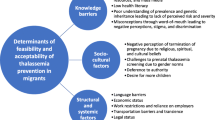Abstract
Thalassemia is one of the most prevalent genetic disorders in Iran. The birth of a child with thalassemia major is associated with many problems for the family, and society. In the present study, the reasons for marriage among people with thalassemia minor in Iran, in spite of receiving medical advice against it, have been investigated. The present study was a qualitative content analysis conducted in 2019 with the participation of 12 couples (24 participants) with thalassemia minor living in Rafsanjan, Iran; and 2 counselors working with thalassemia patients. Data collection was conducted through in-depth interviews. All interviews were recorded and transcribed. The text was read several times, categorized and main themes were extracted according to content analysis methods. The present study shows that giving inadequate or inaccurate information to people, strong emotional attachment between couples, taking the test at the wrong time, family interference and family insistence on marriage, having seen cases with no problems, and specific thoughts and beliefs are the most important reasons for marriage among couples with thalassemia minor in Iran. According to the results of the present study, the importance of providing thorough and accurate information to the public, setting an appropriate time for counseling and screening which is not immediately before the marriage ceremony, and briefing more efficiently at the time of counseling can help prevent marriage among couples with thalassemia minor in Iran.
Similar content being viewed by others
Data availability
The datasets used and/or analyzed during the current study are available from the first author on reasonable request.
References
Ambroggio S, Peris C, Picardo E, Mitidieri M, Minniti E, Benedetto C et al (2016) β-thalassemia patients and gynecological approach: review and clinical experience. Gynecol Endocrinol Taylor & Francis 32:171–176
Ardakani ZB, Akhondi MM, Sadeghi MR, Sadri-Ardekani H (2005) The necessity of a comprehensive study on abortion in Iran. J Reprod Infertil 6:299–320
Cao A, Galanello R (2010) Beta-thalassemia. Genet Med. Nature Publishing Group; 12:61
Cao A, Kan YW (2013) The prevention of thalassemia. Cold Spring Harb Perspect Med. Cold Spring Harbor Laboratory Press; 3:a011775
Fallah M, Samavat A, Zeinali S (2009) Iranian national program for the prevention of thalassemia and prenatal diagnosis: mandatory premarital screening and legal medical abortion. Prenat Diagnosis Publ Affil With Int Soc Prenat Diagnosis. Wiley Online Library 29:1285–1286
Fucharoen S, Winichagoon P (2007) Prevention and control of thalassemia in Asia. Asian Biomed J 1:1–6
Graneheim UH, Lundman B (2004) Qualitative content analysis in nursing research: concepts, procedures and measures to achieve trustworthiness. Nurse Educ Today Elsevier 24:105–112
Green B (2004) Personal construct psychology and content analysis. Pers Constr Theory Pract 1:82–91
Hsieh H-F, Shannon SE (2005) Three approaches to qualitative content analysis. Qual Health Res. SAGE publications Sage CA: Thousand Oaks; 15:1277–88
Jaafari F, Nodeh-Sharifi A, Zaeri F (2006) Effectiveness of thalassemia prevention program on couples knowledge and carriers and marriage couples opting in Gorgan city. Gorgan J Res Med Sci 8:68–72
Karami H, Jalali H, Mahdavi M, Mahdavi MR (2017) Identification of a neonate with thalassemia intermedia despite premarital screening program in Mazandaran Province (co-inheritance of Hb Knossos and IVS II-1 G> A Mutations). Res Mol Med. Research in Molecular Medicine; 5:34–6
Karimzaei T, Masoudi Q, Shahrakipour M, Navidiyan A, Jamalzae AA-Q, Bamri AZ (2015) Knowledge, attitude and practice of carrier thalassemia marriage volunteer in prevention of major thalassemia. Glob J Health Sci. Canadian Center of Science and Education; 7:364
Kashfi SM, Mohaghegh Sharifi E, Rakhshani T, Hosseini SS (2018) Tests for the prevention of thalassemia major in the couples referring to Behbahan Health Center, Iran during 2006–2016. J Human, Environ Heal Promot. Journal of Human, Environment and Health Promotion; 4:116–20
Khodaei GH, Farbod N, Zarif B, Nateghi S, Saeidi M (2013) Frequency of thalassemia in Iran and Khorasan Razavi. Int J Pediatr. Mashhad University of Medical Sciences; 1:45–50
Kiani A, Ghorbani Aliabadi E (2019) Investigating the causes of beta thalassemia after start of prevention program in Jiroft City during 2001–2015. J Jiroft Univ Med Sci. Journal of Jiroft University of Medical Sciences; 6:168–77
Kosaryan M, Vahidshahi K, Siami R, Nazari M, Karami H, Ehteshami S (2009) Knowledge, attitude, and practice of reproductive behavior in Iranian minor thalassemia couples. Saudi Med J 30:835–839
Li C-K. New trend in the epidemiology of thalassaemia. Best Pract Res Clin Obstet Gynaecol. Elsevier; 2017;39:16–26.
Loukopoulos D (2011) Haemoglobinopathies in Greece: prevention programme over the past 35 years. Indian J Med Res. Wolters Kluwer—Medknow Publications; 134:572.
Mahdavi SA, Jafari A, Azimi K, Dehghanizadeh N, Barzegar A (2020) Therapeutic abortion in Iran: an epidemiologic study of legal abortion in 2 years. BMC Res Notes Springer 13:1–6
Monni G, Peddes C, Iuculano A, Ibba RM (2018) From prenatal to preimplantation genetic diagnosis of β-thalassemia. Prevention model in 8748 cases: 40 years of single center experience. J Clin Med. Multidisciplinary Digital Publishing Institute; 7:35
Prasomsuk S, Jetsrisuparp A, Ratanasiri T, Ratanasiri A (2007) Lived experiences of mothers caring for children with thalassemia major in Thailand. J Spec Pediatr Nurs. Wiley Online Library; 12:13–23
Rezabeigi Davarani E, Khanjani N, Rezabeigi Davarani M, Daneshi S (2019) The effect of genetic counseling and health care in reducing the incidence of major beta-thalassemia in Kerman Country in 2017. 12th Conf Heal Sci Updat. Shahid Behesti University, Tehran, Iran
Rezabeigi Davarani E, Khanjani N, Rezabeigi Davarani M, Daneshi S (2019) The Incidence rate of Major Thalassemia and its etiology in Kerman, Iran; from 2012 until 2017. 12th Conf Heal Sci Updat. Shahid Behesti University, Tehran, Iran
Rezabeigi Davarani E, Mohseni Takaloo F, Vahidnia A, Daneshi S, Rezabeigi Davaranid M, Khanjani N et al (2020) Epidemiological investigation of a twenty-year major β-thalassemia surveillance in Kerman. Iran Arch Hyg Sci 9:265–274
Sadaghiani S, Faridi M (2001) Knowledge and attitude of couples about Thalassemia before marriage in Bandar Abbas. Hormozgan Med J 5:33–43
Sarker SK, Islam MT, Bhuyan GS, Sultana N, Begum MN, Al Mahmud-Un-Nabi M et al (2018) Impaired acylcarnitine profile in transfusion-dependent beta-thalassemia major patients in Bangladesh. J Adv Res. Elsevier 12:55–66
Shaianmehr M, Abassi M, Zareipour MA, Sadaghianifar A (2016) Premarital screening of beta thalassemia in Urmia county of northwest Iran during 2014: a short report. J RafsanjanUniv Med Sci 14:903–910
Sapountzi-Krepia D, Roupa Z, Gourni M, Mastorakou F, Vojiatzi E, Kouyioumtzi A, et al (2006) A qualitative study on the experiences of mothers caring for their children with thalassemia in Athens, Greece. J Pediatr Nurs. Elsevier; 21:142–52
Sargolzaie N, Montazer Zohour M, Ayubi E, Shahraki F (2018) Relationship between social determinants of health and the thalassemia prenatal diagnosis test in Zahedan, south eastern Iran. Hemoglobin. Taylor & Francis; 42:231–5
Seyam SH, Assemi A (2010) Study of the knowledge in Guilan University students about thalassemia. J Urmia Nurs Midwifery Fac 8:150–155
Silvestroni E, Bianco I (1975) Screening for microcytemia in Italy: analysis of data collected in the past 30 years. Am J Hum Genet. Elsevier; 27:198
Singha K, Fucharoen G, Fucharoen S (2021) δ-Hemoglobinopathies in Thailand: screening, molecular basis, genotype-phenotype interaction, and implication for prevention and control of thalassemia. Ann Hematol 100:1953–1963
Tosto F, Salvatore M, Falbo V, Floridia G, Censi F, Bombieri C, et al (2009) The Italian scheme of external quality assessment for β-thalassemia: genotyping and reporting results and testing strategies in a 5-year survey. Genet Test Mol Biomarkers. Mary Ann Liebert, Inc. 140 Huguenot Street, 3rd Floor New Rochelle, NY 10801 USA, 13:31–6
Wong LP, George E, Tan J-AMA (2011) A holistic approach to education programs in thalassemia for a multi-ethnic population: consideration of perspectives, attitudes, and perceived needs. J Community Genet. Springer; 2:71–9
Zeinalian M, Moafi AR, Fadayi-Nobari R (2013) A study to evaluate the results of pre-marital screening program for beta-thalassemia in Isfahan province, 1997–2010. Sci J Iran Blood Transfus Organ 10:20–30
Acknowledgements
The authors thank the couples and counselors who participated in this study.
Funding
This study was supported by Grant No. 99000058 from Kerman University of Medical Sciences.
Author information
Authors and Affiliations
Contributions
FH and NK conceived and drafted the manuscript. NK critically reviewed the manuscript. All authors read and approved the final manuscript.
Corresponding author
Ethics declarations
Ethics approval and consent to participate
Ethics approval was obtained from the Ethics Committee of Kerman University of Medical Sciences (Ethics code: IR.KMU.REC.1399.127).
Consent for publication
Not applicable.
Competing interests
The authors declare no competing interests.
Additional information
Publisher's note
Springer Nature remains neutral with regard to jurisdictional claims in published maps and institutional affiliations.
Rights and permissions
About this article
Cite this article
Hasanshahi, F., Khanjani, N. Investigating the reasons for marriage among couples with thalassemia minor, in Iran. J Community Genet 12, 507–513 (2021). https://doi.org/10.1007/s12687-021-00540-5
Received:
Accepted:
Published:
Issue Date:
DOI: https://doi.org/10.1007/s12687-021-00540-5




